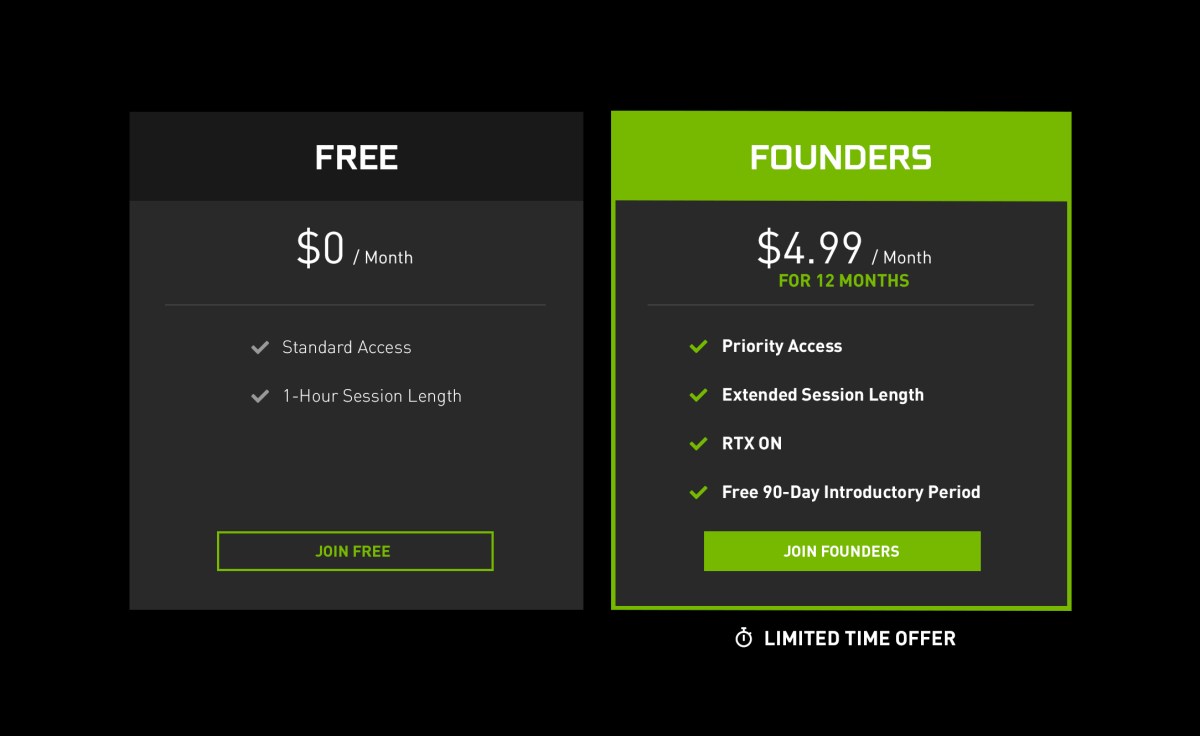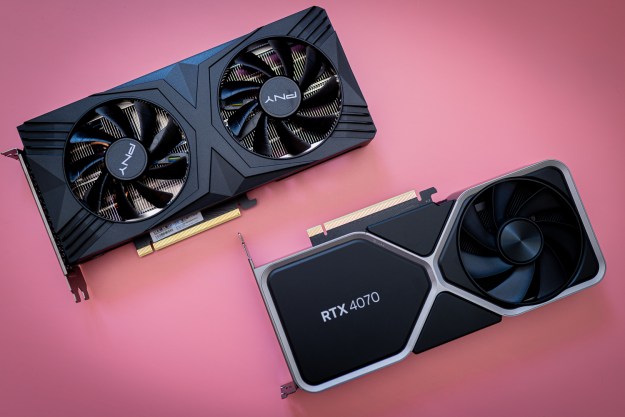You might not know it, but Nvidia has quietly toiled on its own cloud gaming platform for several years. I went hands-on with the GeForce Now beta two years ago. Though it looked in good shape then, Nvidia decided to keep it in testing. Until now.
- Nvidia GeForce Now undercuts Stadia’s pricing
- GeForce Now touts game ownership
- PC, Mac, and Android supported, iOS is not
- 1080p at 60 FPS is the target
- The client isn’t changing for launch
- Carbon neutral is planned, but Nvidia’s not there yet
- Global support is coming through partners
- Watch out, Stadia. GeForce Now looks competitive.
GeForce Now is live today, Tuesday, February 4th. Gamers in 30 countries throughout North America and Europe can sign up for the service. The beta’s waitlist is gone.
Nvidia GeForce Now undercuts Stadia’s pricing
Nvidia’s pricing is aggressive. Players can sign up as Founders, the only paid tier, at $4.99 for 12 months. That provides priority login access, session length of up to six hours, access to RTX raytracing, and a free 90-day introductory period.
That severely undercuts Google Stadia, which starts at $9.99 per month. It also beats competitors like Shadow, which begins at $12.99 for an annual plan.

While the Founders pricing is aggressive, it’s also temporary. Nvidia will raise the price sometime after its initial launch. Nvidia isn’t revealing when the price will increase or how much it will be. Gamers who sign up for the Founders plan now, though, lock in the introductory rate for a year.
There’s also a free tier with a few notable restrictions. Session length is capped at one hour, after which the session will end (even mid-game) and players will have to log back in. Free players will be placed behind Founders subscribers in the login queue and won’t have access to RTX raytracing. Nvidia says payment information isn’t required for the free tier, and you can register today.
The free tier’s one-hour session length sounds limiting. Still, Jordan Dodge, Senior PR Manager for Nvidia GeForce Now and Nvidia Shield, says that the average session length was slightly less than an hour during the service’s beta.
GeForce Now touts game ownership
GeForce Now’s subscription looks a lot like Stadia or PlayStation Now, but there’s a major difference (aside from price). Nvidia isn’t operating an online storefront. It also isn’t bundling games into a subscription.
Instead, players can bring their own games from other PC storefronts like Steam, Epic, and GOG. GeForce Now works as a cloud PC, and only as a cloud PC. You’ll log in to Steam, Epic, or GOG separately to play games purchased on each service.
It’s like you’re renting a GeForce PC in the sky.
Nvidia is touting that as a perk. Stadia subscribers must purchase games through Stadia and can only play those games through Stadia. GeForce Now lets subscribers bring their existing game libraries and, if they decide to stop using GeForce Now, subscribers still own the games through whichever digital store used to buy them.
“We connect directly into the PC version,” said Dodge. “You’re running the PC Versions of the game. It’s like you’re renting a GeForce PC in the sky.”

That avoids the problem facing
Several hundred games are available for “instant play.” They are pre-installed in the cloud service and playable the moment you own them. Other games need to be installed before you can play them. Nvidia is, of course, promising to expand the instant lineup over time.
PC, Mac, and Android supported, iOS is not
Nvidia is launching GeForce Now with support on PC, Mac, and Android.
Support for iOS is missing, though, and it won’t be coming anytime soon. Nvidia’s Jordan Blade said reporters should “talk to Apple on that one,” suggesting an impasse between the two companies. I emailed Apple for comment but did not receive a response.
The client itself is very slim; Nvidia says it’ll weigh in under 100 megabytes. Games are installed and played in the cloud, so they don’t require additional local storage.
1080p at 60 FPS is the target
Unlike Stadia, which is touting 4K, Nvidia decided to limit the service to 1080p resolution at 60 frames per second. This is true on all platforms and devices. Nvidia says the service technically could support resolutions above 1080p, but that won’t be enabled for now. It’s “exploring” future support of
Instead, the company is focusing on latency. Dodge said the company expects to deliver “the lowest latency around the world.”

Nvidia also wants to lean on the power of its hardware. GeForce Now will be the only cloud gaming service to offer raytracing, a feature that’s likely to remain unique for some time.
That doesn’t mean every GeForce Now player will have full access to a single Nvidia GPU in its data center, and resources may be shared between players. The split of resources will vary based on how graphically demanding a game is.
The limitations on resolution and framerate are disappointing, but Nvidia thinks GeForce Now offers a big boost in image quality for most players. Dodge said 80 percent of beta testers were “playing on a machine that otherwise couldn’t play that game.”
The client isn’t changing for launch
While GeForce Now is just now coming out of beta and launching to the public, its beta rollout was broad, and feature-filled. The client was smooth, and the game list was extensive. Don’t expect major changes to come as part of release.
In fact, Nvidia says the only client update will “articulate the membership plans” and let players manage their subscription. Otherwise, the GeForce Now client will look as it did before.
Carbon neutral is planned, but Nvidia’s not there yet
Gaming on Nvidia’s GeForce Now will eliminate the need for powerful local hardware, but only offsets the environmental impact. Nvidia’s own data centers consume energy, and that consumption can increase overall power use.

I wrote about the environmental impact of Google Stadia, and other cloud gaming services, last year. Dr. Evan Mills, a retired Senior Scientist at the Lawrence Berkeley National Laboratory, told me that “in our calculations for PC cloud gaming, the datacenter is responsible for about 340 Watts of power per user, and the network an additional 180 watts.”
Nvidia is planning to address that problem by going carbon neutral, but the company isn’t there yet. “That is a big concern here at Nvidia,” said Jordan Dodge. “We do have efforts to reduce consumption in our data centers. We’re actively working on policies to work to carbon neutral, but at this point, we’re not there yet.” Nvidia hasn’t set a date for achieving carbon neutral.
Global support is coming through partners
The launch of GeForce Now targets the United States and Europe, but the service will also come to Russia, Japan, and Korea.
Nvidia is rolling out the service in these regions through the GeForce Now Alliance. This partnership pairs Nvidia’s technology with telecom companies operating in each country.
The rollout of GeForce Now is handled by each telecom partner, so Russia, Japan, and Korea aren’t seeing the service’s full release quite yet.
Watch out, Stadia. GeForce Now looks competitive.
GeForce Now isn’t a perfect offering. Higher resolution and framerates would be appreciated, and I would’ve liked a fresh client UI for launch.
Yet it’s hard to argue with the price and games list. Founders paying $4.99 per month will fork a hair under $60 per year, less than MSRP for a single full-price game. That undercuts Google’s Stadia, and unlike Stadia, GeForce Now is launching with over 1,000 compatible games. Nvidia also isn’t tying game ownership to the service, so compatible games are playable before and after players subscribe.
Nvidia GeForce Now is available immediately. PC and Mac players can download the client from Nvidia’s website, while
Editors' Recommendations
- Nvidia just made GeForce Now so much better
- All ray tracing games on PC: AMD Radeon and Nvidia RTX ray tracing
- Nvidia’s DLSS 3.5 update is what ray tracing always wanted to be
- Nvidia DLSS 3: explaining the AI-driven gaming tech
- Nvidia’s DLSS 3.5 update flips ray tracing on its head



